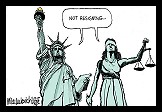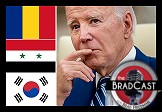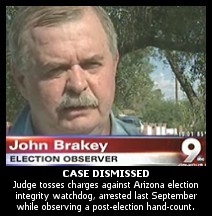Guest Blogged by Ernest A. Canning
Part I of a Five-Part Special Series
(Part II is now here. Part III is now here. Part IV is now here. Part V is now here.)
"When any modern state tortures even a few victims, the stigma compromises its majesty and corrupts its integrity. Its officials must spin an ever more complex web of lies that, in the end, weakens the bonds of trust and the rule of law that are the sine qua non of a democracy. And, beyond its borders, allies and enemies turn away in collective revulsion." - Prof. Alfred W. McCoy, A Question of Torture (2006).
 Truth and justice are essential components of democracy and the rule of law. We cannot move forward unless we honestly examine our past. Accuracy is vital to every decision we make, be it impeachment, prosecution or a restoration of our nation’s honor and integrity.
Truth and justice are essential components of democracy and the rule of law. We cannot move forward unless we honestly examine our past. Accuracy is vital to every decision we make, be it impeachment, prosecution or a restoration of our nation’s honor and integrity.
This is the first in a five-part series of articles which will strive to correct misperceptions arising from the erroneous blending of military and CIA torture. This task has become especially relevant now that the Justice Department's the Office of Legal Counsel (OLC), the very section which had issued the torture memos, tasked by former Attorney General Michael Mukasey with investigating itself, has now released a recommendation that none of the authors of the torture memos be prosecuted. This recommendation stands in stark contrast to our nation's post-World War II decision to prosecute German judges for war crimes at Nuremberg.
Part I addresses the relatively public involvement of the U.S. military and private contractors at Guantanamo, Afghanistan and Iraq. It will dispel the notion that the Bush White House sought out independent legal opinions from the OLC before deciding to torture.
Part II will discuss the CIA's dark beginnings, including its recruitment of former Nazis, its devotion to covert "psychological operations" as a founding principle, the experiments on unwitting subjects that were part of a maniacal quest to crack the code of human consciousness, and the scientific studies that led to KUBARK, the CIA's torture manual.
Part III provides a vital historical account of CIA torture applied by surrogates in developing nations as a component of empire, an account that belies the suggestion made by the The New York Times that CIA torture first arose as an aftermath of 9/11.
Part's IV and V will address the CIA's involvement in extraordinary rendition and an ultra-secret system of “black-sites” into which “ghost detainees” would disappear. It will show how the techniques used on "ghost detainees" are the culmination of a half-century of CIA research and practices...


 Trump Gets Trumped in Our Musky Year-End Roundtable: 'BradCast' 12/19/24
Trump Gets Trumped in Our Musky Year-End Roundtable: 'BradCast' 12/19/24 'Green News Report' 12/17/24
'Green News Report' 12/17/24
 About Some of Trump's
About Some of Trump's Trump Family Corruption Cometh...So Does Our Oppo-sition: 'BradCast' 12/17/24
Trump Family Corruption Cometh...So Does Our Oppo-sition: 'BradCast' 12/17/24 'Green News Report' 12/17/24
'Green News Report' 12/17/24 Mistallied Contests Found in OH County, as Oligarchy Rises in D.C.: 'BradCast' 12/16/24
Mistallied Contests Found in OH County, as Oligarchy Rises in D.C.: 'BradCast' 12/16/24 Sunday 'Barrel Bottom' Toons
Sunday 'Barrel Bottom' Toons Trump Admits He Can't Lower Grocery Prices (Biden Just Did): 'BradCast' 12/12/24
Trump Admits He Can't Lower Grocery Prices (Biden Just Did): 'BradCast' 12/12/24 'Green News Report' 12/12/24
'Green News Report' 12/12/24 What 'Unprecedented and Powerful Mandate'?: 'BradCast' 12/11/24
What 'Unprecedented and Powerful Mandate'?: 'BradCast' 12/11/24 Trump Barely Won Nationally, But Won 'News Deserts' By a Landslide: 'BradCast' 12/10
Trump Barely Won Nationally, But Won 'News Deserts' By a Landslide: 'BradCast' 12/10 'Green News Report' 12/10/24
'Green News Report' 12/10/24 Bad Weekend for Authorit-arianism; Also: To Pardon or Not?: 'BradCast' 12/9/24
Bad Weekend for Authorit-arianism; Also: To Pardon or Not?: 'BradCast' 12/9/24 Sunday 'Teeny Tiny' Toons
Sunday 'Teeny Tiny' Toons Fox 'News' and GOP Get Their Hateful War on Trans Kids at SCOTUS: 'BradCast' 12/5/24
Fox 'News' and GOP Get Their Hateful War on Trans Kids at SCOTUS: 'BradCast' 12/5/24 'Green News Report' 12/5/24
'Green News Report' 12/5/24 'Mind Boggles at Potential Corruption' in Trump Scheme: 'BradCast' 12/4/24
'Mind Boggles at Potential Corruption' in Trump Scheme: 'BradCast' 12/4/24 In Defense of Democracy from S. Korea to N. Carolina: 'BradCast' 12/3/24
In Defense of Democracy from S. Korea to N. Carolina: 'BradCast' 12/3/24 Hunter's Pardon: 'BradCast' 12/2/24
Hunter's Pardon: 'BradCast' 12/2/24 How (and Why!) to 'Extend Olive Branch' to MAGA Members: 'BradCast' 11/21/24
How (and Why!) to 'Extend Olive Branch' to MAGA Members: 'BradCast' 11/21/24 Former Prosecutor: Sentence Trump in NY Before Taking Office: 'BradCast' 11/20/24
Former Prosecutor: Sentence Trump in NY Before Taking Office: 'BradCast' 11/20/24 'Bullet Ballot' Claims, Other Arguments for Hand-Counting 2024: 'BradCast' 11/19/24
'Bullet Ballot' Claims, Other Arguments for Hand-Counting 2024: 'BradCast' 11/19/24 Trump Already Violating Law During Transition: 'BradCast' 11/18/24
Trump Already Violating Law During Transition: 'BradCast' 11/18/24 Computer Experts Ask Harris to Seek Hand-Counts After Breaches: 'BradCast' 11/14/24
Computer Experts Ask Harris to Seek Hand-Counts After Breaches: 'BradCast' 11/14/24
 VA GOP VOTER REG FRAUDSTER OFF HOOK
VA GOP VOTER REG FRAUDSTER OFF HOOK Criminal GOP Voter Registration Fraud Probe Expanding in VA
Criminal GOP Voter Registration Fraud Probe Expanding in VA DOJ PROBE SOUGHT AFTER VA ARREST
DOJ PROBE SOUGHT AFTER VA ARREST Arrest in VA: GOP Voter Reg Scandal Widens
Arrest in VA: GOP Voter Reg Scandal Widens ALL TOGETHER: ROVE, SPROUL, KOCHS, RNC
ALL TOGETHER: ROVE, SPROUL, KOCHS, RNC LATimes: RNC's 'Fired' Sproul Working for Repubs in 'as Many as 30 States'
LATimes: RNC's 'Fired' Sproul Working for Repubs in 'as Many as 30 States' 'Fired' Sproul Group 'Cloned', Still Working for Republicans in At Least 10 States
'Fired' Sproul Group 'Cloned', Still Working for Republicans in At Least 10 States FINALLY: FOX ON GOP REG FRAUD SCANDAL
FINALLY: FOX ON GOP REG FRAUD SCANDAL COLORADO FOLLOWS FLORIDA WITH GOP CRIMINAL INVESTIGATION
COLORADO FOLLOWS FLORIDA WITH GOP CRIMINAL INVESTIGATION CRIMINAL PROBE LAUNCHED INTO GOP VOTER REGISTRATION FRAUD SCANDAL IN FL
CRIMINAL PROBE LAUNCHED INTO GOP VOTER REGISTRATION FRAUD SCANDAL IN FL Brad Breaks PA Photo ID & GOP Registration Fraud Scandal News on Hartmann TV
Brad Breaks PA Photo ID & GOP Registration Fraud Scandal News on Hartmann TV  CAUGHT ON TAPE: COORDINATED NATIONWIDE GOP VOTER REG SCAM
CAUGHT ON TAPE: COORDINATED NATIONWIDE GOP VOTER REG SCAM CRIMINAL ELECTION FRAUD COMPLAINT FILED AGAINST GOP 'FRAUD' FIRM
CRIMINAL ELECTION FRAUD COMPLAINT FILED AGAINST GOP 'FRAUD' FIRM RICK SCOTT GETS ROLLED IN GOP REGISTRATION FRAUD SCANDAL
RICK SCOTT GETS ROLLED IN GOP REGISTRATION FRAUD SCANDAL VIDEO: Brad Breaks GOP Reg Fraud Scandal on Hartmann TV
VIDEO: Brad Breaks GOP Reg Fraud Scandal on Hartmann TV RNC FIRES NATIONAL VOTER REGISTRATION FIRM FOR FRAUD
RNC FIRES NATIONAL VOTER REGISTRATION FIRM FOR FRAUD EXCLUSIVE: Intvw w/ FL Official Who First Discovered GOP Reg Fraud
EXCLUSIVE: Intvw w/ FL Official Who First Discovered GOP Reg Fraud GOP REGISTRATION FRAUD FOUND IN FL
GOP REGISTRATION FRAUD FOUND IN FL



















 Yet another state backs the conservative, Constitutional principle of equal protection under the law for all, as Maine's Gov. John Baldacci signs the legislature's newly approved bill,
Yet another state backs the conservative, Constitutional principle of equal protection under the law for all, as Maine's Gov. John Baldacci signs the legislature's newly approved bill,  Keith Olbermann
Keith Olbermann  Reagan on torture prosecution,
Reagan on torture prosecution, 
 Guest Blogged by Coleen Rowley, FBI whistleblower,
Guest Blogged by Coleen Rowley, FBI whistleblower,  The former State Department adviser to Condoleezza Rice and executive director of the 9/11 Commission, Philip Zelikow, disclosed
The former State Department adviser to Condoleezza Rice and executive director of the 9/11 Commission, Philip Zelikow, disclosed  At the same time he took a step forward,
At the same time he took a step forward,  The AP has finally noticed the long-sought criminal investigation ballot count of the 2006 Pima County (Tucson), AZ, special election. State Attorney General Terry Goddard's hand-count of the disputed Regional Transportation Authority (RTA) election was concluded, at least for now, in Phoenix on Wednesday. That's when
The AP has finally noticed the long-sought criminal investigation ballot count of the 2006 Pima County (Tucson), AZ, special election. State Attorney General Terry Goddard's hand-count of the disputed Regional Transportation Authority (RTA) election was concluded, at least for now, in Phoenix on Wednesday. That's when  In a related note: Tucson election integrity advocate John Brakey saw charges against him dismissed by a judge today, following his arrest ordered by Pima County election officials last year during a state-mandated, post-election hand-count --- a statutory mandate that likely would not have existed were it not for Brakey's advocacy for such post-election "audits."
In a related note: Tucson election integrity advocate John Brakey saw charges against him dismissed by a judge today, following his arrest ordered by Pima County election officials last year during a state-mandated, post-election hand-count --- a statutory mandate that likely would not have existed were it not for Brakey's advocacy for such post-election "audits." Along with everything else that's been going on over the past week or two in the criminal investigation hand count of the 2006 Pima County (Tucson), AZ, special election (see our detailed special coverage
Along with everything else that's been going on over the past week or two in the criminal investigation hand count of the 2006 Pima County (Tucson), AZ, special election (see our detailed special coverage  I'm impressed, frankly, with the unflinching outspokenness of Meghan McCain (John's daughter) in her quest to restore sanity, and a future, to the Republican Party. No idea whether she'll have any success --- at least for the foreseeable future --- but her willingness to stand straight up to her own party's not-minimal thuggery is impressive.
I'm impressed, frankly, with the unflinching outspokenness of Meghan McCain (John's daughter) in her quest to restore sanity, and a future, to the Republican Party. No idea whether she'll have any success --- at least for the foreseeable future --- but her willingness to stand straight up to her own party's not-minimal thuggery is impressive.













